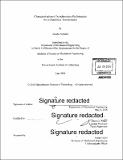| dc.contributor.advisor | Amos G. Winter. | en_US |
| dc.contributor.author | Antonini, Amado | en_US |
| dc.contributor.other | Massachusetts Institute of Technology. Department of Mechanical Engineering. | en_US |
| dc.date.accessioned | 2016-12-05T19:59:15Z | |
| dc.date.available | 2016-12-05T19:59:15Z | |
| dc.date.copyright | 2016 | en_US |
| dc.date.issued | 2016 | en_US |
| dc.identifier.uri | http://hdl.handle.net/1721.1/105717 | |
| dc.description | Thesis: S.B., Massachusetts Institute of Technology, Department of Mechanical Engineering, 2016. | en_US |
| dc.description | Cataloged from PDF version of thesis. | en_US |
| dc.description | Includes bibliographical references (pages 50-51). | en_US |
| dc.description.abstract | Synchronizers are a ubiquitous component of almost every type of transmission in modem vehicles. They are mechanical devices whose function is to ensure that components rotating at different rates can be harmonized smoothly and without eroding their surfaces. They are responsible for both the durability of the transmission and the comfort of the passengers. This work analyzes the capabilities and limitations of synchronizers to be used in a novel transmission. It is a contribution to a larger project whose goal is to develop a hybrid, clutchless transmission for a performance vehicle that will improve efficiency by eliminating the friction and mechanical losses inherent in a traditional clutch. An overview of the synchronization process is presented followed by a simplified mathematical model of the common baulk-ring synchronizer. The model is experimentally validated in order to make predictions of the device's performance on the new transmission. Several simulated scenarios are then developed that provide information that is critical for designing synchronizers for the clutchless transmission. Matlab code was developed for these simulations and is provided at the end for replication of the results. Considering the demanding environment under which the synchronizers are expected to operate in the clutchless transmission, the possible failure modes of the synchronizer components are investigated. Finite element analysis (FEA) is used to predict the maximum loads on the synchronizer ring before the material yields. An energy analysis is also performed to ensure that the energy dissipation rate of the friction surfaces is adequate. | en_US |
| dc.description.statementofresponsibility | by Amado Antonini. | en_US |
| dc.format.extent | 56 pages | en_US |
| dc.language.iso | eng | en_US |
| dc.publisher | Massachusetts Institute of Technology | en_US |
| dc.rights | M.I.T. theses are protected by copyright. They may be viewed from this source for any purpose, but reproduction or distribution in any format is prohibited without written permission. See provided URL for inquiries about permission. | en_US |
| dc.rights.uri | http://dspace.mit.edu/handle/1721.1/7582 | en_US |
| dc.subject | Mechanical Engineering. | en_US |
| dc.title | Characterization of synchronizer performance for a clutchless transmission | en_US |
| dc.type | Thesis | en_US |
| dc.description.degree | S.B. | en_US |
| dc.contributor.department | Massachusetts Institute of Technology. Department of Mechanical Engineering | |
| dc.identifier.oclc | 964671952 | en_US |
